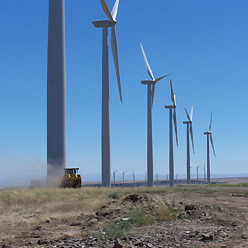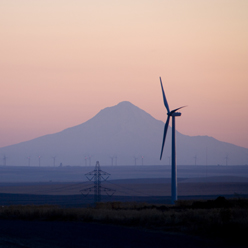forum
library
tutorial
contact

Wind Developers Look to Gorge
by April StreeterNW Current, October 31, 2006
|
the film forum library tutorial contact |

|
Wind Developers Look to Gorgeby April StreeterNW Current, October 31, 2006 |
 The wind that whistles steadily between the high, glacially carved cliffs of the Columbia River Gorge have turned the area into a windsurfers' paradise. But soon the Gorge may become famous for another wind-driven wonder: thousands of energy-producing wind turbines.
The wind that whistles steadily between the high, glacially carved cliffs of the Columbia River Gorge have turned the area into a windsurfers' paradise. But soon the Gorge may become famous for another wind-driven wonder: thousands of energy-producing wind turbines.
Wind energy development in the Columbia River Gorge is not entirely new. The Stateline Wind Project, still the Pacific Northwest's largest at 300 megawatts, has been spinning out electricity since 2001. While it took most of the past decade to build the first 1,000 megawatts (MW) of wind power in the entire region, in the next two to three years one-and-a-half times that amount is planned for development.
A continual rise in energy prices has made wind increasingly cost-competitive, while the U.S. Congress' start-and-stop production tax credit, now set to expire at the end of 2007, goads bona fide developers into getting financed projects built quickly [see "Catching the wind," nwcurrent, March 2005].
Couple U.S. trends with the Gorge's combination of good wind, a strong grid and potential renewable portfolio standards in both states, and you've got the makings for a powerful wind market.
In August 2006, the first two arrivals in a new crop of wind projects went online. Leaning Juniper 1, a 101 MW project near Arlington, Ore., owned by MidAmerican subsidiary PacifiCorp; and Big Horn, a 200 MW project in Klickitat County, Wash., developed by Scottish Power Co. subsidiary PPM Energy, together added more than half of the 500-plus MW of capacity the Gorge is expected to add to the grid by the end of 2007.
What makes the Gorge enticing for wind development is only partly the wind itself. Surprisingly, it is in part the two states' legacy of hydropower development which is aiding the new wind rush.
"There's adequate wind here, if not exactly screaming," said Dana Peck, project manager for Horizon Wind Energy, owned by Goldman Sachs (NYSE: GS).
Horizon has no Gorge-area project plans Peck is willing to describe, but she agreed Horizon is heavily prospecting there. "The hydropower system created a transmission system that is amazing," she said. "There's phenomenal transmission capacity."
The well-developed regional grid makes it easier for wind developers to get their projects connected and generating cash once turbine towers are in the ground and blades start turning. It also makes it convenient to export to power-hungry California. The wind energy from Big Horn's turbines, for example, is being sold to MSR, the Modesto, Santa Clara and Redmond Public Power Agency, under a long-term contract.
This is not to say the grid can effortlessly absorb all the new wind power without new substations. The Northwest's grid operator, the Bonneville Power Administration (BPA), has added three substations in the last year to handle new wind. The newest is in Arlington, Ore.
Also, because wind is a variable power resource, BPA must continue to plan for backup power needed when wind dies down and turbines stop spinning. Hydropower created from dams is a good match with wind because it can be more easily increased and decreased to fill wind's gaps than nuclear or gas plants.
 But the backup required to fill in for increasing amounts of wind doesn't come without a cost.
But the backup required to fill in for increasing amounts of wind doesn't come without a cost.
"We think we'll be okay for the next couple of years," said Elliot Mainzer, BPA's manager of customer service planning and engineering. "But beyond two or three or even four thousand additional megawatts, that's when wind integration issues come to the fore." [see "Getting wind to the grid," nwcurrent, Sept. 2006]
BPA, along with the Northwest Power and Conservation Council, is preparing a plan that anticipates about 6,000 MW of wind built in the area over the next 20 years.
If real estate's magic formula is location, location, location, in wind power it is location, location and public policy. Texas overtook California as the nation's No. 1 wind energy producer this year partly as a result of its passage of a renewable portfolio standard (RPS) in 2001, said Rachel Shimshak, executive director of the Renewable Northwest Project.
Nineteen states now have some sort of an RPS, and Washington may well be next with Initiative 937 on the November ballot. I-937 requires large utilities to obtain 15 percent of their electricity from new renewable sources such as wind by 2020. It also requires utilities to "undertake cost-effective energy conservation."
Oregon is right behind. A task force appointed by Gov. Ted Kulongoski (D) is working on a plan in which Oregon would attempt to get 25 percent of its energy from renewables by 2025.
Shimshak said the experience of other states has shown that RPS' have a negligible impact on electricity rates, if any effect at all. She added that Washington's goals are easily achievable over the initiative's 14-year time span.
"As wind gets closer to where people live, there will be a demand on the industry to consider the design and aesthetics of new wind plants - to make turbine layouts more attractive to the eye," Peck said. "But at the same time, I think in the Northwest people have the information they need to weigh in on whether they are willing to have wind turbines in the view from their deck. Some won't be, but I think most will."
learn more on topics covered in the film
see the video
read the script
learn the songs
discussion forum
